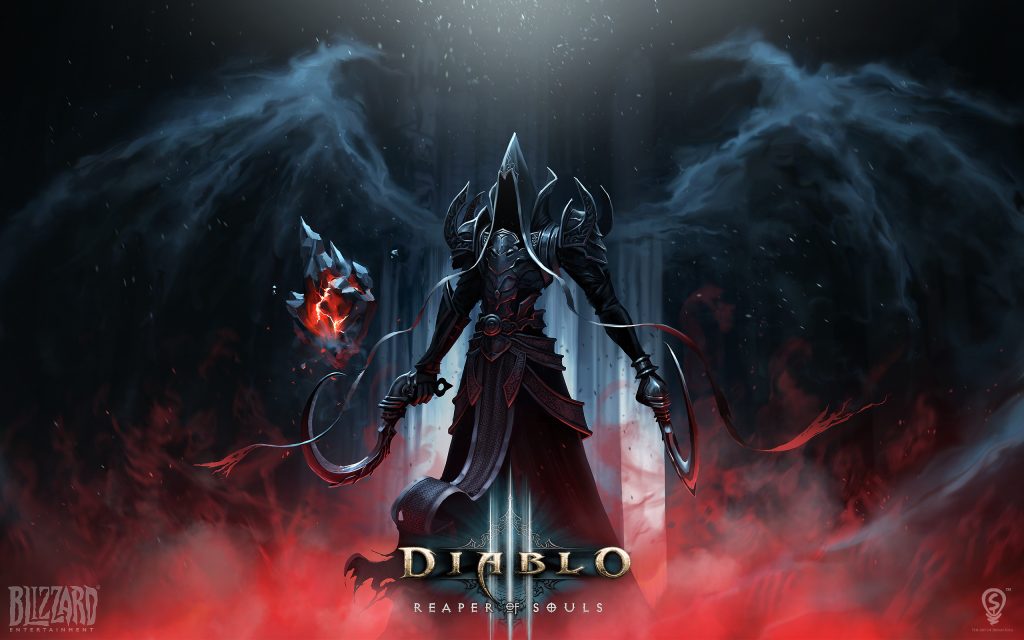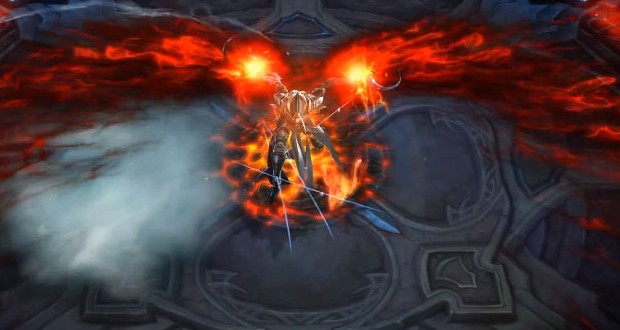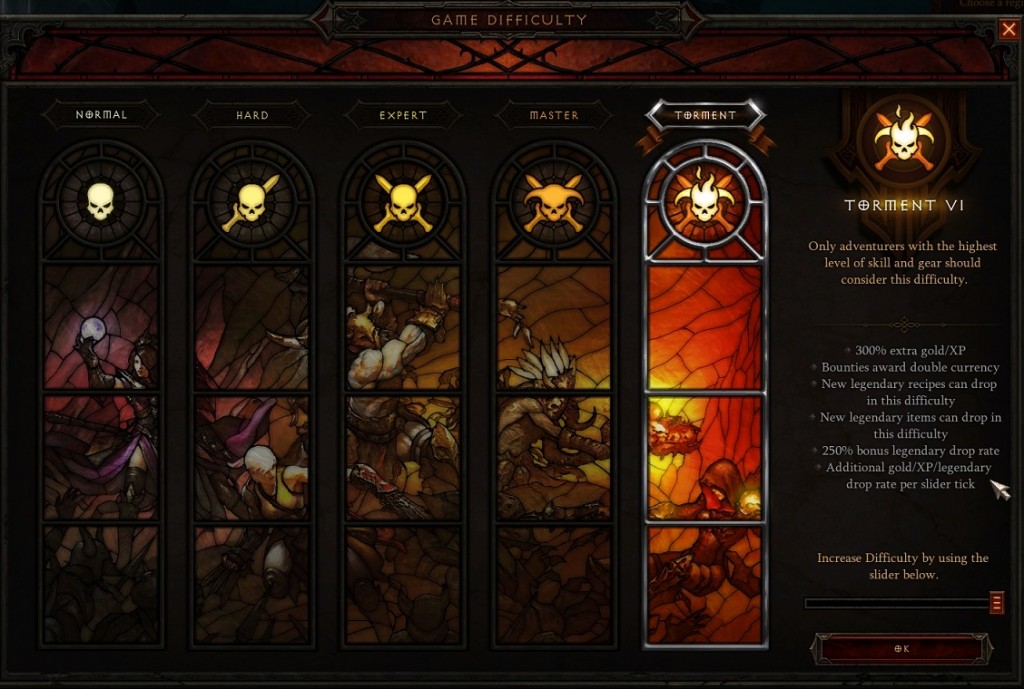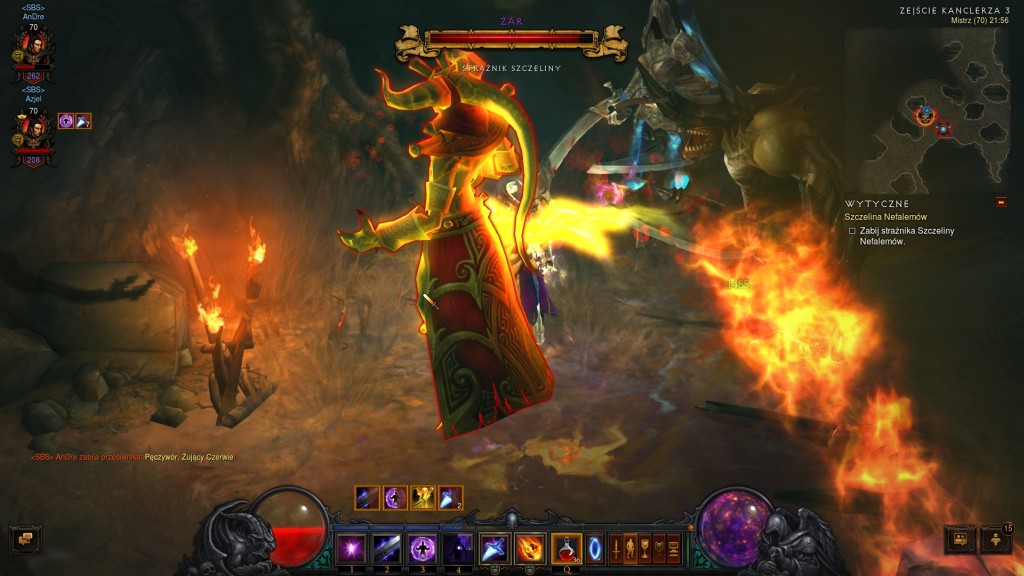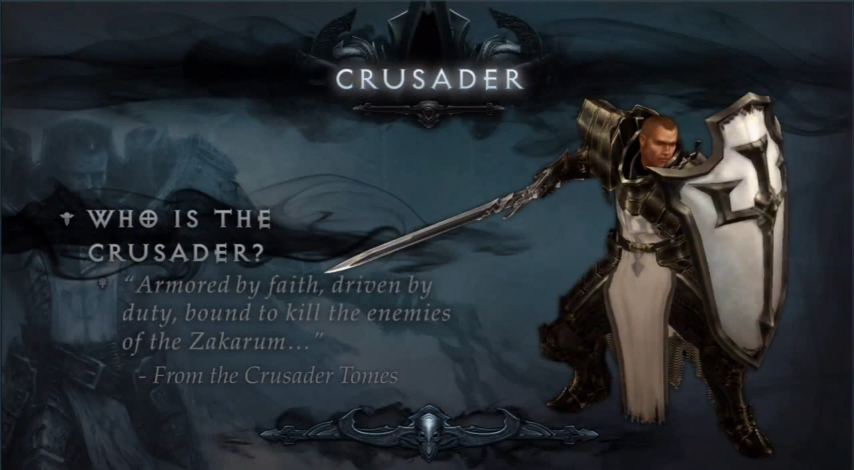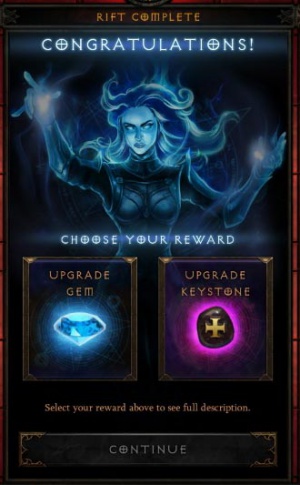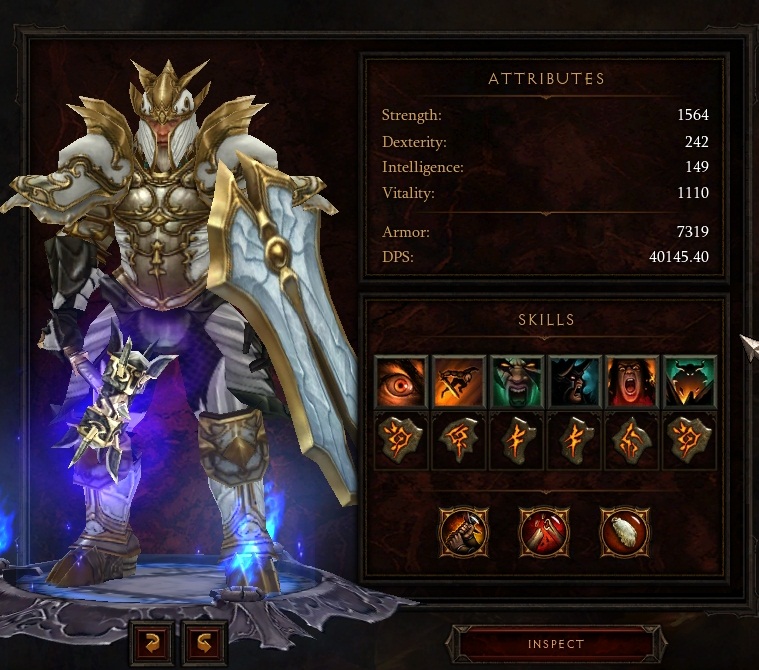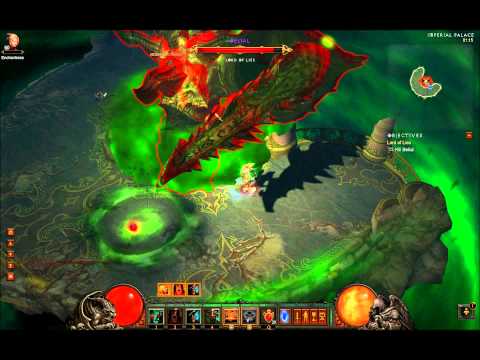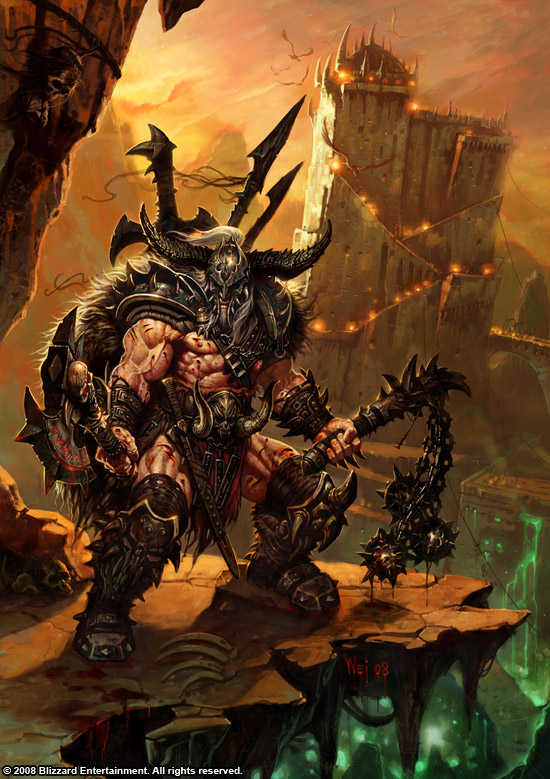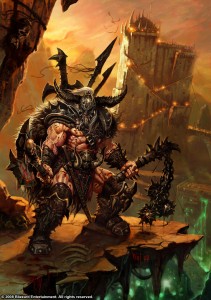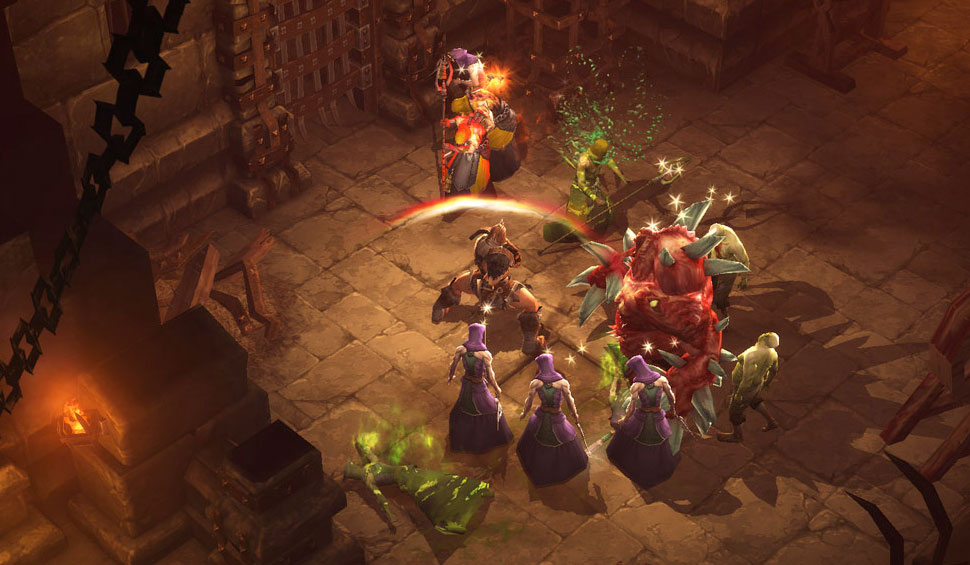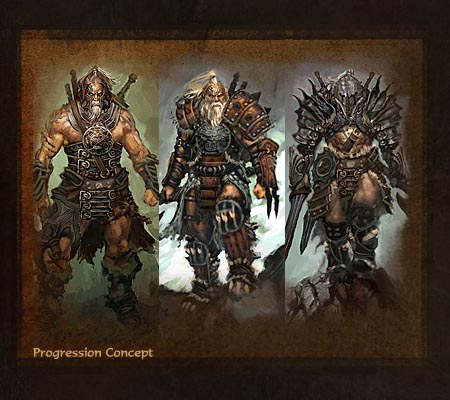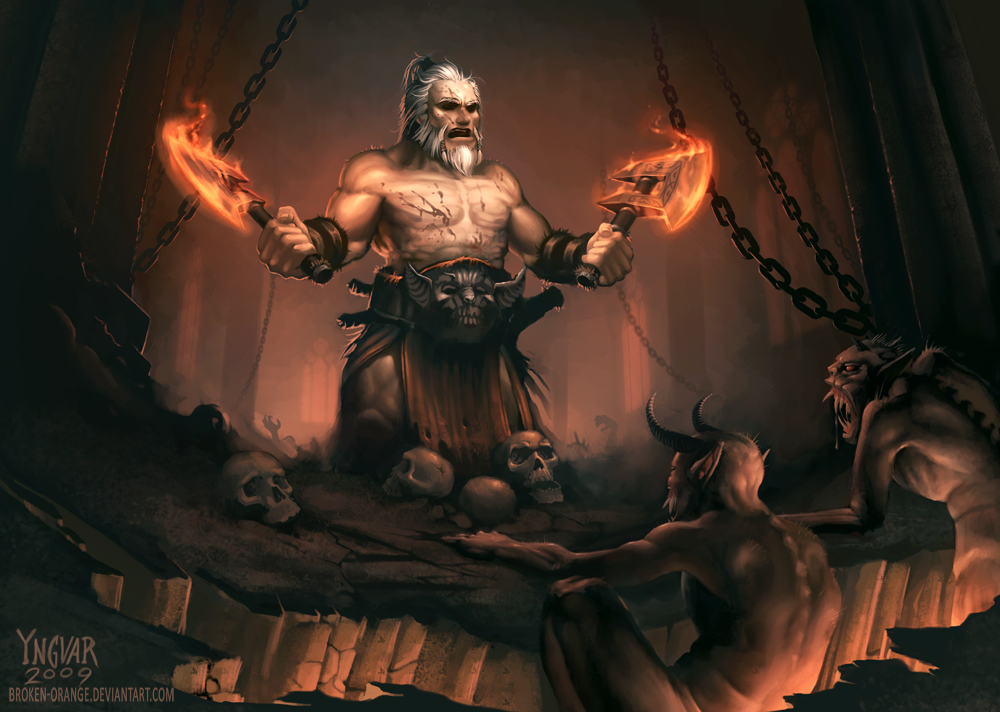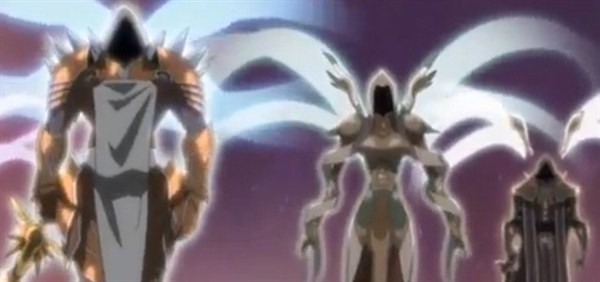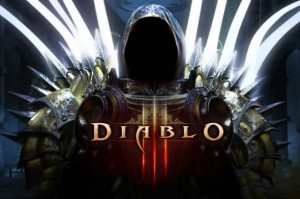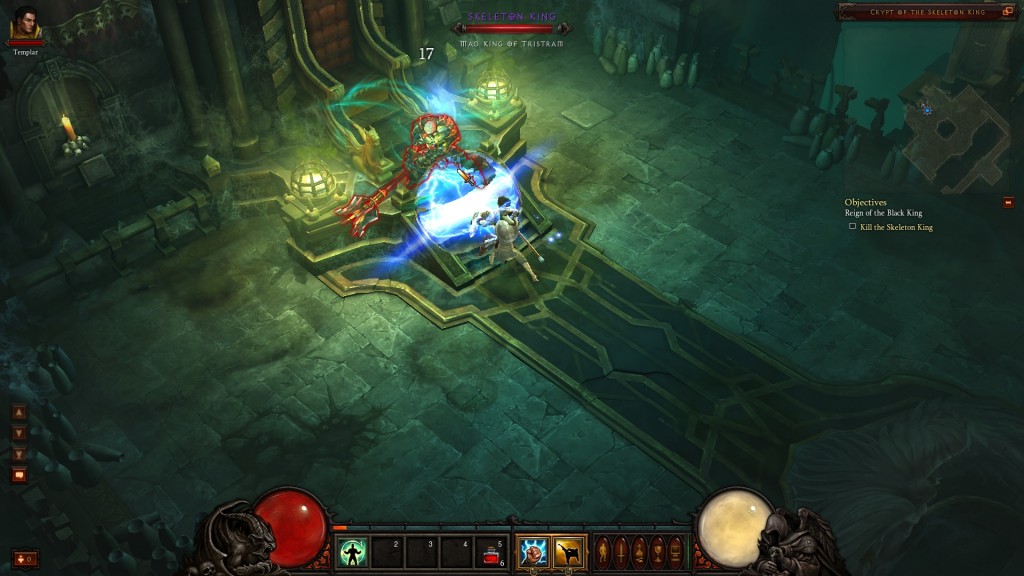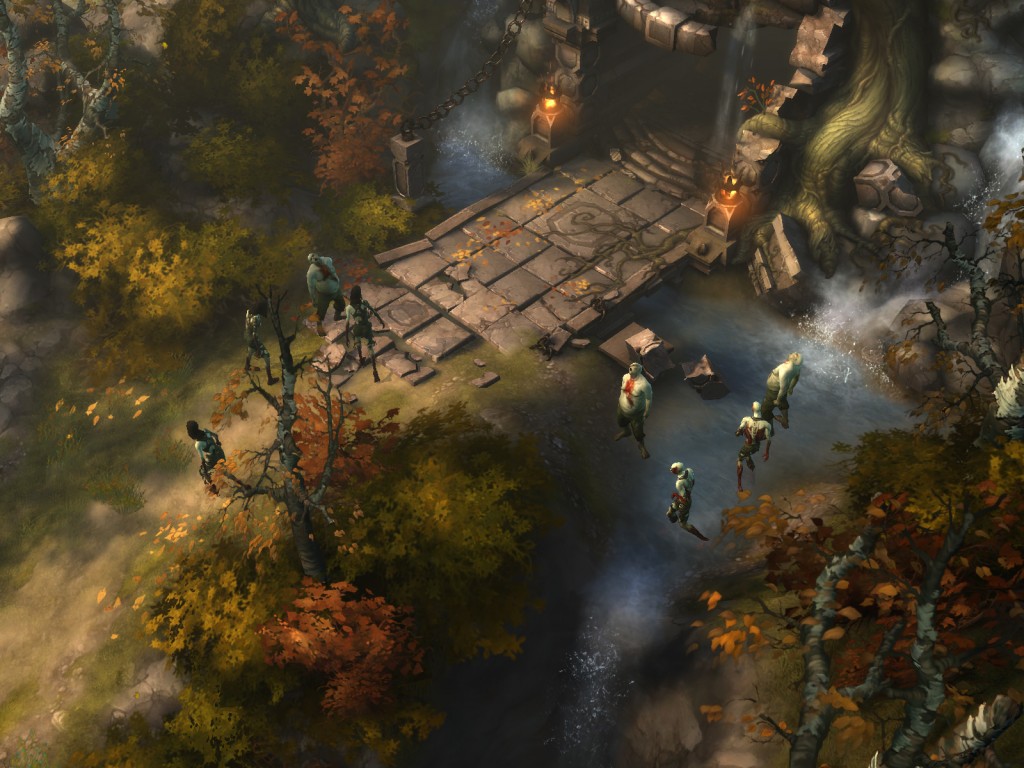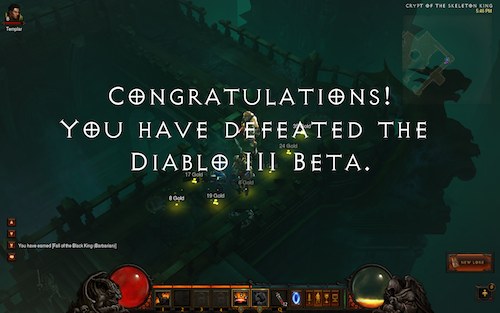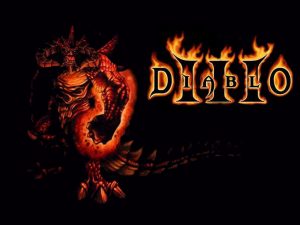Diablo 3 was very good out of the gate. I played extensively and farmed the endgame for 2-3 months during the sumer of 2012 — even clearing Inferno before it was nerfed. But my interest dropped off around the time the Monster Power patch released and I stopped playing until Reaper of Souls (the expansion). Now I’ve been addicted ever since. Blizzard is the only “big” game company I know that really continues to “fix” a big game long after release (fully online games tune over time as well). Diablo 3 had problems, and over the course of 2 years, without changing the fundamental gameplay, Blizzard managed to transform a good game into a great one.
Infernal Wall
Almost all of Diablo 3‘s problems centered around the endgame. Broadly, there were two main problems: the “gear/progress disconnect ” and the “Inferno Wall.” I discussed these both back at the time, but simply put, as originally designed, the endgame consisted of a single difficulty mode: Inferno, chopped into roughly 3 sub-difficulties (Act I, Act II, and Act III/IV). Because of the relatively small number of gradients it was just HARD. Brutally hard. And as the ONLY route at first to progress was gear, this whole problem was made worse by…
The Great Gear Disconnect
Basically, in Vanilla D3 you never got any gear you could use. Gear was so randomized, and so stingy, and the requirements of Inferno so steep and class specific, that even the Legendary drops you got were basically useless. Probably, they were useless to anyone, but certainly they were to your class. This all meant you had to buy them on the new “all player all world” Gold or Real Money auction houses. That meant that only gold was really useful — which is pretty boring. You were left feeling that to progress you had to either spend real money or grind mindlessly for gold ad nauseam.
If we establish the premise that in a “progress” oriented game, the player will pursue the activity which offers the best rewards, Vanilla D3 favored gold farming — super boring. There was no sense of direct progress from clearing actual content. I’m going to discuss Blizzard’s modifications and point out how they modified player incentive.
It should also be noted that Nephalem Glory buff really encouraged playing in 1-2 hour stints, which is kind of long.
Difficult Adjusts
The first thing Blizzard changed, and quite rapidly, was to adjust the difficulty down a bit. They also increased the relative power of Legendaries (initially they were pretty lame). These modifications helped a tiny bit, slightly incentivizing gear as good Legendaries could sometime sell well on the Auction House. Sometimes.
Paragon for the Win
Next up, they added a new “leveling at max level” system called Paragon. Basically, your earned experience leveled a separate Paragon Level that gave you small stat increases. There were 100 Paragon levels with steep experience brackets. It certainly took many hours per, and grew and grew and grew such that reaching high levels was only for the insane. Still, this system was a huge improvement. At least you “got” something for playing other than gold and the small increased attack and survivability actually felt like slow progress. In a month or so of casual play I only leveled to Paragon 7, which helped a little to power up my character.
Paragon further incentivized players to actually clear content, although the huge disconnect still existed.
Monster Power
Next Blizzard introduced “Monster Power”, essentially a difficulty slider within Inferno where you could adjust monster difficulty commensurate with gold/magic find bonuses. This more or less solved the Infernal Wall problem and moved things to the now familiar choice: “munch through monsters fast and easy” or “live on the edge, where a tough pack might be the end.” Progress then consisted of getting enough better gear to notch the difficulty up. This change evened out the difficulty in the various acts, allowing you to play a broader range of content disconnected from its difficulty (before you had to play the Act you could clear).
It should also be noted that Blizzard fixed tons of minor tuning and introduced Infernal Machines, a method to construct really difficult portals and fight Uber-bosses.
Gear 2.0
These early changes (in the Spring/Summer of 2012) helped, and pretty much fixed the difficulty problems. Still, for nearly two years, the relationship between gear and play was totally broken. You bought progress on the Auction House and that was it. Blizzard’s great Real Money AH experiment was (at least for players) a failure.
So they shut it down.
While patch 2.0 dropped just before the Reaper of Souls Expansion, I’m going to discuss both together because level 60 play on patch 2.0 forms an irrelevant (and brief) historical window.
Blizzard changed the whole gear system. The Auction House went away and instead gear was no longer fully randomized. All the affixes became at least relevant to your spec. They rearranged them into primary and secondary. Certain types of gear gained specific reliable affixes or special powers (still), but basically almost all drops became at least usable, and perhaps 1 in 10 well rolled for what they were. It’s hard to overestimate how important this was.
Before, you’d look at a legendary drop casually and 99% of the time it was for another class, or contained totally nonsensical stats (like Intelligence on a Barbarian Weapon), now it was mostly usable, if not ideal. They also redid lots of special power affixes and set bonuses and introduced lots of new Legendaries. I’ll discuss later how this affected things.
This drastically altered player motivation. Progress became much closer related to how many Legendaries you got. It was no longer purchased on the now non-existent AH, but earned in game by clearing mobs.
Enchanting Fun
The Mystic, a new craftsman who enchants and transmogrifies was also important. You can select one affix per item to permanently change, re-rolling it again and again to make it perfect. This substantially improves the odds that a piece of gear is well rolled. It need only be well rolled in all but one slot. You can replace the worst slot, and with sufficient gold, fix it.
Hop to 70
Reaper of Souls raised the level cap to 70. This short little grind, only a few hours basically served to invalidate the old 1.0 level 60 gear and start a new clean gear grind. Which was fine.
Extra Content
They also added a fifth act. It’s fine. It brings in more level variety. Great. Not a big deal, but fine.
They added a new class. I haven’t played him. If I make a new character I will. Again, something cool, and good for the really serious Altaholic, but not game-changing.
Torment is the New Inferno
Blizzard also simplified the old difficulty system of mode + monster power into a single mode slider with the top difficulty levels being labeled Torment I, Torment II, etc. (up to T6). It’s not really much different, and still gives that choice of how hard vs. how much reward.
Story versus Grind
One of the weird things about Vanilla D3 endgame play was that you constantly ran “sections” of it’s long campaign mode again and again to grind for better gear and experience (after Paragon). This always felt odd and only certain maps really made for good grinding. With ROS, Blizzard introduced a new Adventure Mode that allowed for hopping around anywhere in the world and earning XP bonuses from randomly generated “Bounties” sliced all through the map. This chunked up gameplay into smaller 5 minute chunks (or 15-20 if you pounded out the 5 bounty meta reward) and made the process of just killing monsters without skipping through dialog you had heard 100 times much more streamlined.
The also added a new mode, Rifts, where a special token (earned completing bounties) could be used to open a special monster heavy randomly generated monster free-for-all. 1-4 players race through this collection of 1-7 maps clearing. Once you’ve cleared enough a mini-boss pops up and gives you more goodies, XP, and Shards. Rifts featured a Legendary drop bonus.
All this served to mix up player motivation and encourage you to clear bounties or rifts all over the world. Increased drop rates for multiplayer encouraged that as well.
Shard It or Make It
With the auction houses gone, players need to grind out their gear IN the game — which is better. Shards, which are mostly collected from rift runs, can be spent at the Shard Vendor to get a chance at a Legendary in a specific slot. The odds are low, but reasonable, so basically, this allows you to accelerate the acquisition of a good piece in the slot where you need it most. Overall, it’s a huge boon and makes the Random Number Generator less frustrating.
In Vanilla, the Blacksmith and crafting in general felt useless. The odds of getting a decent piece out of him were so low as to be pathetic. But in 2.0, many crafted items are fairly competitive. Sure if you want a great roll you might have to craft 20 of them, but before it was probably 200.
Overpowered Feels Good
One of the other things that dropping the AH did was to allow Blizzard to adjust the balance. Before, weird extra affixes like Gold Find and the like had to be kept carefully in check, because earning gold too fast would draw too many players in. Now, gold showers down all over the place and if you want to stack it, fine. Which brings us to the new modes of endgame progress. The higher Torment levels (T4-6) are calibrated such that no normal build really cuts it. You have to go overpowered. The difference is just in which way you go overpowered.
Typically, the various strategies lie in some combination of 1 or more sets and a couple of build variants. For example, as a Barbarian there are a couple set builds that start to “break the game” like Leapquake and Raekors/Vile. But they don’t really break the game. They are needed to progress at the higher torments. Leapquake for example combines the Strength of the Earth bonuses that allow each Leap to also spawn an Earthquake with Lut Socks, which allows for 3 Leaps per cooldown. Stack Cooldown Reduction, align all your elemental damage to one element and stack that, and you can boost your damage through the roof. To clear T6, you have to do just that. Access to this many set items requires a serious play investment. Getting really well rolled pieces in each slot even more.
Really, it’s kinda brilliant.
The New Paragon
Paragon too got a nice retuning. Instead of a brutal climb to 100, with small predetermined gains, it became a more or less endless grind to (?) 800 or beyond. Each level takes roughly an hour. Each gives you a point that applies toward all your characters (encouraging alts) that can be spent on one of 16 stats in groups of 4. At first glance these seem like very small gains but by the time you reach the Paragon 200-400 range you have enough points to round out or adjust certain rare stats or ones your gear lacks. Don’t have enough Movement Speed on your gear? Put some points in it. Your build favors Cooldown Resist? Paragon helps. Need more healing and toughness? Go for it.
This also adjusts player motivation by incentivizing experience and making even a session with no useful drops (most of the time at high level) feel at least somewhat useful.
Greater Rifts and Legendary Gems
By the time patch 2.1 rolled around, many serious players (like myself) were farming Torment VI (T6) without too much trouble. So Blizzard added a new rift mode called Greater Rifts which allows for a kind of infinite rift progression. Rifts are ranked 1-100 in ascending difficulty. Much like regular rifts you kill monsters to unlock a boss, but in this case it’s under 15 minute time pressure. If you succeed you may upgrade your “key” to a higher level. If you choose not to progress, or fail, you can minorly upgrade the new Legendary Gems (which are pretty badass). Your chance of upgrades is related to the level of rift so that it is only really possible to upgrade your gems to roughly the level you can complete. The whole idea of Greater Rifts is fairly cool, but I feel they suffer from a number of motivational problems:
- Your starting rift level is based on an annoying “kill a bunch of enemies” trial that often under ranks you, meaning you must slog through 2-3 low level rifts to reach the right level to test your skills.
- The XP/Gold/Legendary rewards are FAR FAR inferior to just running regular rifts. Following the principle that players will go where the rewards are, this means that you need to run Greater Rifts to upgrade your gems, but they are not otherwise the best choice.
- The luck of the map is a huge factor. If there is a high density of blue/yellow packs it is MUCH easier to clear in time. Some combinations of enemies are far more annoying and time consuming than others.
- The time pressure can be very tight at high levels. This means you have to rush rush rush. That may test a certain skill, but I find it less fun then doing things at my own pace.
- In multiplayer, the key system is very idiosyncratic and often leads to getting stuck in a rift alone or with less people than you intended. If it’s alone, but you had party members, you don’t get your NPC companion or the ability to change to solo gear (I run different gear solo) and it’s an automatic loss.
Overall, I’m not in love with Greater Rifts as a main focus of late endgame progression. However, many of these problems could be easily fixed. For example, if you could select your starting level from any level you have already beaten.
Conclusion
Blizzard has constantly tried to “fix” player motivation in the game to encourage broad balanced play. They experimented with some new ideas like the Auction House, and it failed, so they scrapped it and built a new gear system that better motivated serious and continual play. They seem to still be doing this. It’s an unusual commitment for a game that isn’t subscription or pay-to-play based. Most classic big games are just made, possibly patched to fix drastic bugs, and then left to run their course. Diablo 3, on the other hand, like WOW and other MMOs, is a sort of living evolving thing.
| WOW Endgame series: Vanilla, Burning Crusade, Lich King, Cataclysm, and Pandaria. or read about Mists of Pandaria leveling. Read my Hearthstone Beta Review! If you liked this post, follow me at: My novels: The Darkening Dream and Untimed |

